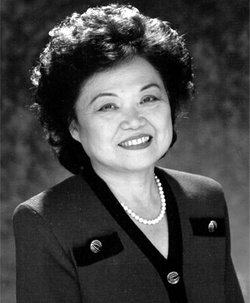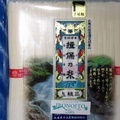2012 is the 40th anniversary of the passage of Title IX in 1972 giving women equal opportunity in education and sports in most colleges and universities. There have been numerous articles recently written about the successes of women athletes because of Title IX. However, nothing has been noted about the fight for this civil and gender rights.
One woman who fought doggedly and passionately advocating women’s issues in Congress, including gender rights was PATSY TAKEMOTO MINK (1927-2002). She garnered critical support for the passage of Title IX when at the time there were only eight women who were members of Congress. She felt a special burden to bear to speak for all women because they didn’t have people who could express their concerns for them adequately.
Patsy T. Mink noticed inequality from her early youth between the white people who owned the island’s plantations and the plantation workers who were mostly Japanese and Filipinos. She further experienced more inequality and injustice when her father was taken in for questioning after the bombing of Pearl Harbor on December 7, 1941 because of his Japanese heritage even though he had been born in Hawaii.
Patsy T. Mink was class president of her class and valedictorian when she graduated from Maui High School at the age of 16 in 1944. She enrolled at the University of Hawaii intending to study medicine. She received her B.A. in zoology and chemistry. Her applications to over 30 medical schools were all turned down, not because of her grades, not entirely because of her Japanese American heritage, but mainly because of her gender.
Therefore, Patsy T. Mink was forced to change the profession by which she could be of service to her community. She was admitted to the University of Chicago Law School. In 1951 she married John Mink who was also attending the Univ. of Chicago studying geology. In 1953 when their daughter, Gwendolyn Matsu Mink, was 6 months old the family moved to Honolulu. She again ran into sexism when no law firm would hire her. So, she opened her own tiny law office and taught business law at the Univ. of Hawaii to supplement her income.
Patsy T. Mink’s career path changed when she became involved with the Young Democrats. She enthusiastically organized the Young Democrats in Hawaii, and was elected National Vice-President. In Nov. 1956 she was elected to the House of Representative for the Territory of Hawaii. In 1959 she was elected to the Territorial Senate. That same year when Hawaii became the 50th State she decided to run for Congress of the U.S., but was defeated by a war hero, Daniel K. Inouye.
In 1964, she again ran for the U.S. Congress and won although she did not have the blessing or financial support from the state Democratic Party. Mink is the first woman of color to serve in Congress. She served 6 terms until 1977 in her first trip to Washington. In the first days of her first term she and a few others protested the seating of the representatives from Mississippi to demonstrate their opposition to the voting practices in the state that excluded African Americans.
Patsy T. Mink took an interest in more than 60 programs on the war on poverty from 1965–1967. Some of her greatest efforts were in the area of education. She wrote bills for the benefit of needy children from pre-school through college and succeeded in getting many of them passed.
Patsy T. Mink’s objection to G. Harrold Carswell’s nomination to the U.S. Supreme Court based on his sexist beliefs resulted in the Senate turning him down. In the fall of 1973 she asked Congress to begin the impeachment process of President Richard Nixon so that the American public would finally know the truth of his actions.
In 1971–1972, Patsy T. Mink ran for President of the U.S. in order to make Americans consider the possibility of a woman president. She was on the ballot in Oregon under the Green Party.
In 1976, Mink again decided to run for the U.S. Senate, but was defeated by another war hero, Masayuki “Sparky” Matsunaga, who could be counted on to stick to the party line. She was too much of a maverick. She was unwilling to allow the party to influence her political agenda.
She served as Assistant Secretary of State for Oceans and International Environmental and Scientific Affairs from 1977–1978. For the next three years she was president of the Americans for Democratic Action. She was elected to the Honolulu city council from 1983–1987. She ran unsuccessfully for governor in 1986 and for mayor of Honolulu in 1988.
When Sen. Matsunaga died in office in 1990, Congressman Akaka was appointed to fill his Senate seat. Patsy T. Mink won Akaka’s House seat in a special election, and served until her untimely death on September 28, 2002 after a month-long hospitalization with pneumonia.
Back in Washington she picked up on the same issues she dealt with before. She, with other women of the House demanded an investigation of Supreme Court nominee, Clarence Thomas, of sexual harassment. She also continued her earlier work for the rights of native Hawaiians and others of Asian descent.
In February of 1997 she introduced a bill that would speed up the naturalization process by eliminating literacy and civics tests for legal immigrants. She felt that “their patriotism and loyalty to the U.S. should be rewarded rather than be hindered by delays in the naturalization process.”
Patsy Takemoto Mink had an illustrious, if not contentious, political career. She served in Congress from 1965–1977 and again from 1990–2002. She sat on the Committee on Education and Labor, Committee on Interior and Insular Affairs, Budget Committee, Government Reform Committee, and others. She introduced or sponsored many bills and legislation. Among the education acts Patsy Mink introduced or sponsored were the first childcare bill and legislation establishing bilingual education, student loans, special education, and Head Start.

Mink with Lyndon Johnson after his trip to Hawaii for a conference on the Vietnam War, February 1966. (from Wikipedia.com)
Although she supported many of President Johnson’s domestic programs she was a critic of the Americanization of the Vietnam War. In September 1967, she refused to support the President’s request for an income tax increase because of her fear that the new revenues would be used for military action rather than the expansion of social programs.
However, one of her greatest legislative triumphs, and one which she is most closely associated with, is author of, and who garnered critical support for passage of, was the Title IX portion of the Education Amendments of 1972. It is referred to as the Patsy T. Mink Equal Opportunity in Education Act. Because of her persistence, passion, and leadership, women of today enjoy participation in competitive sports such as basketball, volleyball, track and field, swimming, tennis, gymnastics, and others.
September 28th is the 10th anniversary of her passing. We should all pause to remember this courageous trail-blazer, who, like many other civil and human rights leaders, made a difference in all our lives, and of our children’s lives.
PATSY TAKEMOTO MINK (1927–2002)
* This article was originally published in The Rafu Shimpo on September 27, 2012.
© 2012 Bob Moriguchi




